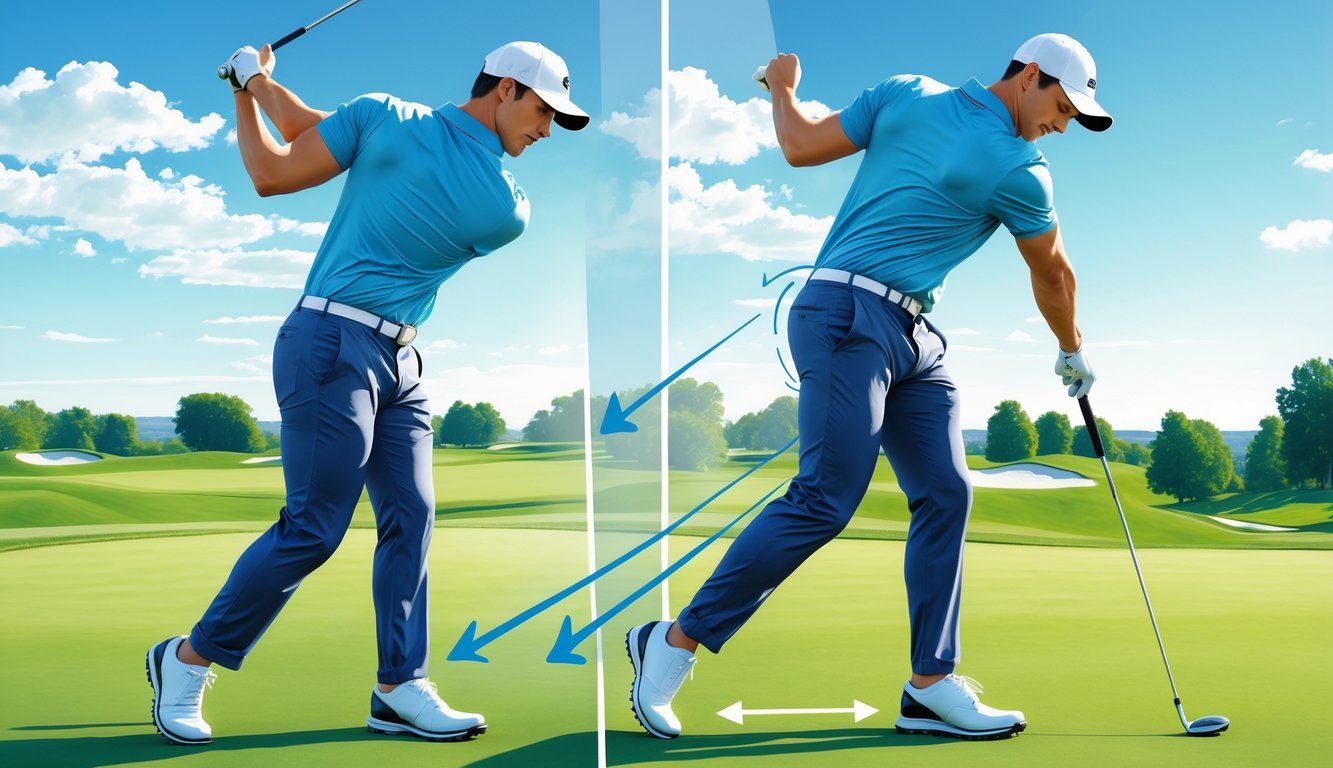PsychNewsDaily Publishers
100 Summit Drive
Burlington, MA, 01803
Telephone: (320) 349-2484
PsychNewsDaily Publishers
100 Summit Drive
Burlington, MA, 01803
Telephone: (320) 349-2484
Weight shift enhances golf swing power and control by transferring body weight smoothly from the back foot to the front foot during the swing for consistent shots.

Weight shift plays a huge role in your golf swing. It helps you hit the ball with more power and accuracy.
When you shift your weight the right way, you move your body weight smoothly from your back foot to your front foot during the swing. That balance lets you generate speed and still stay in control.
If you wait too long to shift your weight, your swing gets rushed or just feels off balance. When you move your weight early, right as you reach the top of your backswing, you stay in rhythm and make better contact with the ball.
Learning how to shift your weight the right way can unlock better shots and way more consistency on the course.
This change might feel weird at first. But after some practice, it starts to feel natural.
Getting weight shift down is honestly one of the simplest ways to upgrade your golf swing and have more fun playing.

To get a solid golf swing, you need good weight shift and a proper stance. You also need smooth movement through each phase of your swing.
As you rotate your hips and upper body, your center of gravity moves. That movement generates power and keeps your swing efficient.
Weight shift moves your body weight from one foot to the other during your swing. At address, most of your weight stays balanced or leans slightly toward your lead foot.
When you start the backswing, your weight goes to the back foot as your hips and upper body rotate.
This shift stores energy in your body. As you move into the downswing, your weight shifts quickly to your front foot.
That transfer, along with hip rotation, creates power. If you time it well, you use the energy you stored without losing balance or control.
Efficient weight shift lets you hit the ball farther while keeping your swing smooth. Without it, your swing feels weak or just unsteady.
A good stance sets the foundation for weight shift. Stand with your feet about shoulder-width apart.
Keep your weight balanced between your feet, or maybe a bit more on your lead foot for a stable base.
Your alignment matters too. Make sure your body and clubface point at your target.
If you line up wrong, your weight shift and rotation won’t work right, and you’ll hit poor shots.
At address, bend your knees just a bit and hold good posture. Keep your center of gravity low and stable.
Grip the club firmly but don’t squeeze it. That lets your wrists and arms move smoothly during the swing.
Start the backswing with a smooth takeaway. As you do, shift your weight to your back foot and rotate your hips and shoulders away from the ball.
Your hips start the pivot, helping you build up energy.
At the top of the backswing, most of your weight sits on your back foot. That upper body rotation tightens your core, getting you ready for the downswing.
During the downswing, shift your weight fast to your front foot and rotate your hips hard. That pulls your upper body through the ball.
From impact to follow through, keep rotating your hips and shoulders toward the target. Finish with most of your weight on your front foot, body facing the target, and balanced.
Timing your weight shift through each phase is key for hitting solid, consistent shots.

Learning to shift your weight the right way helps you stay balanced and create torque. It also lets you make solid contact with the ball.
If you shift your weight properly between your lead foot and trail foot, you get more power and control in your swing. That means better accuracy and faster clubhead speed.
Good balance keeps you in control of your swing. Start with your weight even on your back foot (right foot for righties).
As you coil your upper body and pelvis on the backswing, shift your weight smoothly to your trail foot, but don’t sway or lose your center.
On the downswing, move your weight to your lead foot (left foot) right before impact. This increases compression on the ball and helps you hit it solid.
Staying balanced helps you finish strong and stable. Load your lead side, and let your back foot support your weight without dragging.
Keep this balance to avoid tension and keep your swing mechanics smooth.
A lot of golfers sway too far right on the backswing. That knocks you off balance and wastes energy.
When you sway, it’s tough to get back to the ball in the right spot, so you hit inconsistent shots.
Hanging back happens when you leave too much weight on your back foot after impact. That kills clubhead speed and leads to weak or thin shots.
Slices often come from not shifting your weight enough to the lead side. If your weight and upper body stay right, your clubface opens up, and the ball spins sideways.
To fix this, focus on shifting smoothly and finishing with your weight mostly on your front foot.
Try using an alignment stick behind your back foot. It helps you feel the right weight movement and stops you from swaying or hanging back.
Drills like “shaving strokes” work well. Practice small swings and focus on shifting your weight from your trail foot to your lead foot.
That builds muscle memory and improves your timing.
Golf teachers like to say: start slow, pay attention to your lead foot at impact, and use video feedback to check your finish.
Experiment with different clubs and stances until something feels right.
Don’t forget to warm up. It reduces tension and helps you transfer weight better for more clubhead speed.

When you shift your weight correctly in a golf swing, you move your balance smoothly between your feet. Doing this right keeps you steady and lets you generate more power with control.
You can improve with practice drills and a few handy tools.
Start with most of your weight on your back foot at address. As you take the backswing, let your weight move more to that back foot.
When you swing forward, shift your weight to your front foot to drive the ball.
Keep your weight balanced so you don’t lose control.
Focus on shifting your weight forward during your downswing. Try to feel your front foot getting firmer as you hit the ball.
Practice making smooth steps toward your target to start your weight shift. That helps with control and power.
Try the step drill. Step onto your front foot as you swing to feel the timing of the shift.
Another good one is the slow-motion swing. Focus on moving your weight smoothly between feet.
Both drills help with balance and timing.
Maybe you’re swaying side to side instead of shifting your weight. Tension or bad posture can also make it tough.
Try to keep your upper body steady. Let your hips do most of the work moving your weight.
Hold your spine angle steady through the swing. Don’t move your head too much.
Focus on shifting your weight by rotating your hips, not by sliding your body side to side.
Yeah, you’ll find that balance boards and weighted swing trainers really help you feel how your weight moves.
You can also try devices that clip onto your shoes or hips. These little gadgets give you instant feedback on your weight shift—honestly, they make it way easier to pick up good habits.